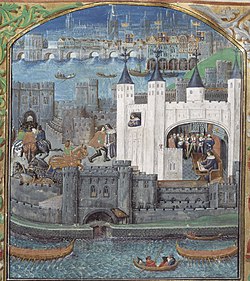


From an early stage of its history, one of the functions of the Tower of London has been to act as a prison, though it was not designed as one. The earliest known prisoner was Ranulf Flambard in 1100 who, [1] as Bishop of Durham, was found guilty of extortion. He had been responsible for various improvements to the design of the tower after the first architect Gundulf moved back to Rochester. He escaped from the White Tower by climbing down a rope which had been smuggled into his cell in a wine casket.
Contents
- 12th century
- 13th century
- 14th century
- 15th century
- 16th century
- 17th century
- 18th century
- 19th century
- 20th century
- References
- External links
Other prisoners include: